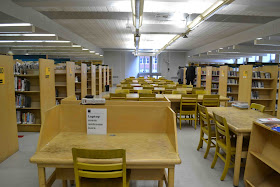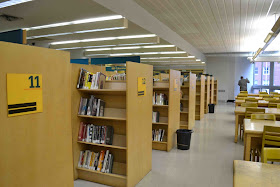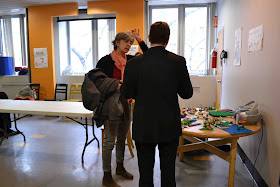Did you catch this?
An Architect Works With a Source of Inspiration: His Father, by Matt A.V. Chaban, June 15, 2015.
It’s a puff piece about architect Jonathan Marvel that appeared in the New York Times, perfectly timed to blunt some bad news about projects Mr. Marvel is the designer of.
And in the background for the big photograph accompanying the piece (did you notice?) like so many of these puff pieces:
Books, books, books! Because
books are reassuring.
Books make you trust people.
Books are read by thoughtful people, cultured people, people who know things and have studied things. Yes, how marvelous to have
books, and how marvelous when you want to present people as trustworthy, to present them as
book people. . . present them as people who love and want to live around books. . . People who, when they want to let the world know who they are think its best to be photographed in front of
books!
We’ll get back to the subject of
books here shortly, because appearances can be deceiving or at least highly ironic.
The two projects about which Marvel urgently needed criticism muffled or distracted from don’t lie very far from each other. Each can also be cited as an example of overbuilding.
 |
| Marvel's two projects: Blocking the view of the Brooklyn Bridge and squashing out a library |
Here’s the bad news with respect to each:
• On June 12, 2015 (reported by the Times June 14, 2015- the day before the puff piece) a judge of the Sate Supreme Court, Justice Lawrence S. Knipel ruled that construction of Marvel’s Pierhouse, a hotel and condominium complex could continue even though it obscures historic views of the Brooklyn Bridge from the Brooklyn Heights Promenade. The building is at least 30 feet in height over what the public was expecting based on negotiated understandings of how development in the park was to be restricted to preserve and respect those views. We’ve been to public meetings where representatives of the Brooklyn Bridge Park Corporation (BBPC) explained how this extra development disrespecting the understood limits occurred. The explanation involves an intricate dance where with a pro-development bias the BBPC and those working with it for the developer two-stepped, figuring that the BBPC was exempt from city zoning laws when it was helpful, and referred to following zoning laws when it was helpful. It is difficult to believe that the architect was not knowingly complicit in this dance that came out with the extra development a developer would want while breaching the understanding that the community expected to followed about protecting the historic views.
• On June 15, 2015, (the day after the puff piece) there was an information dump on the public showing Marvel’s new designed for the 38-story luxury condominium tower that would replace, stomping down to one-third its previous size, the Brooklyn Heights Library, Brooklyn's central destination library in Downtown Brooklyn on Cadman Plaza West at Tillary and Clinton. The information dump was two days before the start of the ULURP (Uniform Land Use Review Procedure), a first hearing about whether the city should sell and shrink this valuable public library property getting virtually nothing in return. The proposal is to sell and shrink the library (which can never be enlarged ever again, like it was in 1993), without even designing a new library first to figure out just how cramped the result might be. But Marvel, the architect working for the developer who wants the site and the library shrunk did lead some Charrettes (Charades) for the BPL about how to shrink the library down design-wise. More on the blindness with which the pro-development Marvel was willing to blithely proceed on this shortly.
Both of these Marvel projects above are the subject of petitions opposing the senseless excess and plunder of the public commons involved. They are respectively:
• The petition of Save the View Now challenging the illegal over-building is here: Return the construction of the Pierhouse in Brooklyn Bridge Park to be consistent with the plans approved in 2005.
• The petition against these deals selling and shrinking NYC libraries is here: Mayor de Blasio: Rescue Our Libraries from Developer Destruction.
It turns out that Marvel’s architects
completely ignored the
entire question of book capacity when it came to conducted three public charrettes/charades about how best to shrink the library down to one-third size and it proposed tentative designs for the replacement library without knwing how many books the current library holds or how many it might be good for the new library to hold.
This is despite the fact that the Marvel architects acknowledge that at these charrette/charades the public clearly expressed that what it wanted in the new library was “Books, Books. Books.”
The following email to Marvel documents that fact in self explanatory fashion.
Email from Citizens Defending Library Co-Founder Michael D. D. White to architect Jonathan Marvel respecting how many books the current central destination library in downtown Brooklyn is designed to hold vs. how many books the drastically shrunken library he is designing would hold.
Mon, May 25, 2015 4:15 pm
Jonathan,
At the design charrette run by Marvel last Monday (the 18th) the Marvel representatives seemed largely unfamiliar about certain things and, for instance, in particular, how many linear feet of book shelf space capacity the current entirety of the 63,000 square foot library including the two half floors underground has vs. how many linear feet of book shelf space capacity the proposed editions of the Marvel design fielded that night were conceptualized to accommodate.
I thought all the Marvel representatives, each and every one of them, were all going to tell me they didn't know the answer, until Guido at the last table said that he knew the answer and he said that the existing 63,000 foot library on all four floors had 4,500 linear feet of book shelf space and that the designs presented furnished 6,000 linear feet of book shelf space. I told him that this seemed implausible to me, especially that the entire 63,000 of buildings space including the basement storage areas has only 4,500 linear feet of book shelf space. I emphasized that the question was linear feet of book shelf space shelf capacity, not the number of number of linear feet of actual books, reduced now that the BPL has been getting rid of books.
Further, since we were clear that we were talking about the all of the entire 63,000 feet of existing library space, there should be no doubt that we were not asking Guido to play games and supply the result of a weird or self-serving allocation of shelf space to only a portion of the library such as to the so-called "branch" functions vs. business and career functions. We also are aware and made clear that not all the book shelf space is in the public areas, so we were asking about ALL the shelf space wherever it was, underground, in staff or conference areas.
I will withhold comment on whether we think the number of linear feet provided for in the new designs were envisioned feasibly or workably or how many feet there actually appear to be. Among other things, readable scales were not provided that night, and things appeared cramped.
As none of the other tables or Marvel representatives that night had the information about the amount of relative shelf space, as things got underway, I conveyed Guido's information to them all together with my misgivings about its plausibility. Interestingly, at my table the head librarian argued for the rest of our table to believe the information furnished by Marvel via Guido.
Frankly, we find Guido's information about shelf space suspect and inconsistent with what we know about the 63,000 square foot library at the corner of Tillary Clinton. Nevertheless, I am writing this email to ask that you confirm (or correct) the information Guido furnished at the design event hoping that you will appreciate the opportunity to do so.
Marvel didn’t respond to the email, but later, at a May 27, 2015 Brooklyn Community Board 2 Youth and Education Committee meeting where the BPL and Marvel were making a presentation to the committee pitching for a sell and shrinkage of the library the architects were asked again to state the book capacity of the current library vs. the proposed shrunken library and this time flatly admitted that they didn’t know what that was. Instead, they offered that it was information that they could sometime obtain and make available. They haven’t yet. . .
They haven’t furnished the information which means that Community Board 2 is being asked to approve the library sale and shrinkage
without this basic information about the library’s core function.
Mr. Guido Hartray’s representation that the whole 63,000 square foot library had
only 4,500 linear feet of shelf capacity amounts to a representation that the library has shelf capacity for maybe only 32,400 or 33,000 books at most. Yet, in 1992, with a rapidly growing collection that the library was expanding by one-third to accommodate better, the library had 130,000 books plus substantial other materials so the shelf capacity then (and probably added to later as well), should have likely have exceeded at least18,000 linear feet by that year.
The well-timed puff piece tells us cheerfully that working on projects like these two in Brooklyn* Jonathan Marvel’s practice “has already doubled in size to 65 designers, with no space left to grow” to accommodate Mr. Marvel and his books!
(* Relevant to each of these projects is the fact that Marvel, along with his library development team partner of the library have been sending money to Mayor de Blasio. See: Saturday, June 6, 2015, WNYC Reports Mayor de Blasio’s “Furiously Raising Funds”- Including From Developers “Lurking Behind The Curtain” of Library Real Estate Sales- And WNYC’s Money?)
“No space left to grow”? Oh my! That means that Mr. Marvel finds himself in pretty much in the same spot as he is putting the library he is shrinking in. . . The shrunken library, stuck at the bottom of a residential building under a stack of luxury condominiums will never be able to grow again afterwards. As noted, the last time the library needed to grow, at appreciable public expense and inconvenient was with its expansion completed in 1993. The library won’t be able to grow if this reverse-course shrinkage is a mistake, or because the city, borough, central baseness district or immediately surrounding neighborhood all grow at a fast rate (which they absolutely are doing).
So yes, it’s
“marvelous” to have books and being pictured in front of them is a great strategy to encourage people to have good feelings about you. . . . But it doesn’t mean that the person photographed cares about and is dedicated to other people having books. It doesn’t mean that although an architect undertakes to design a library (shrunken or not) that the architect cares on whit about that library having books.
By the way, Marvel Architects has only designed one library prior to this one. It was hired to design that library back in the old era of libraries as we used to have them.
 |
| Click to enlarge and inspect book titles |
In the photograph, most of the titles of the books in Mr. Marvel’s Library can be read. The Brooklyn Heights downtown Brooklyn Library is a central destination library, at least the second most important in Brooklyn. Want to guess how many of the titles in Mr. Marvel’s collection can be found in the library when you pop in to visit? In fact, want to guess how many of these titles can be fund in the entire Brooklyn Public Library system now run by people who seem dedicated to
getting rid of books?



































































































